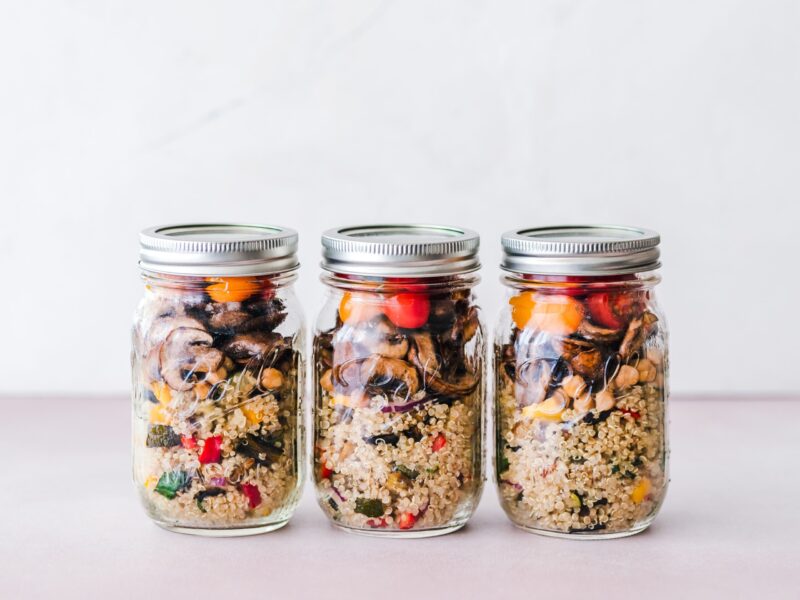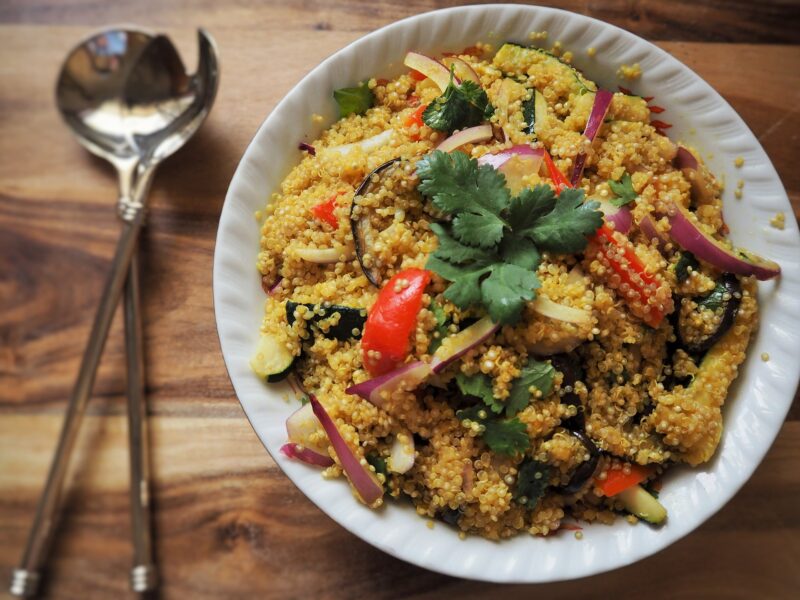January 2024 Quinoa Confused? Read Our How-To Guide!
By Lydia Sinanian
Quinoa has become popular over the past two decades ever since new technology has made harvesting and processing quinoa easier and therefore more readily available to people all over the globe. Quinoa is now spotted everywhere from restaurant menus to granola bars, but we still get a lot of questions about it—is it a seed or grain? Is it a protein or carbohydrate? Maybe you’re quinoa confused or you’re already onboard—either way, we’ve compiled our best “how-to” guide for preparing this nutritious food.
What is quinoa?
Quinoa is a seed from a plant native to the Andes region of South America. Despite being a seed, nutritionally it is classified as a whole grain, and is often referred to as an ancient grain. However, it differs from many other whole grain products as it is gluten-free. The most common types of quinoa are white, black, and red.
What Are the Nutritional Benefits of Quinoa?

Different colors of quinoa vary slightly in their nutrient content, however, all varieties are packed with vitamins and minerals, and are an excellent source of both protein and fiber. Quinoa contains B vitamins, iron, magnesium, and zinc. These vitamins and minerals are used throughout the body to support energy production, wound healing, and immune system health. These nutrients are harder to find outside of meat and dairy products, which, along with its protein content, make quinoa a beneficial food to incorporate if you are vegetarian, vegan, or looking to increase your intake of plant-based alternatives to meat.
The fact that quinoa contains both protein and fiber together is another reason to consider adding this food to your grocery list! Combining protein and fiber together in a meal causes food to digest slower, allowing for a steady release of energy and blood sugar. This means that we are less likely to experience large blood sugar spikes and crashes that can leave us feeling fatigued.
Here’s a quick recap of quinoa nutrition facts:
- Naturally gluten-free
- Rich in B vitamins, iron, magnesium, and zinc
- High in fiber
- Source of plant-based protein
So, you’ve read through the nutrition benefits of quinoa, but maybe you have had a less than savory (pun intended) experience with quinoa in the past that caused you to rule it out. Did you find it bitter, or not quite the texture you were craving? If so, it may have been that the quinoa was not prepared properly. Let’s walk through some tips for cooking quinoa and explore a few creative uses of this versatile grain!
How to Prepare Quinoa:
- What color should I choose? Lighter varieties of quinoa tend to have a milder flavor than darker varieties, making them the best option for someone who is new to cooking or eating this grain.
- Do I really need to rinse quinoa? This is the key to reducing bitterness! The quinoa plant is savvy and self-protective, and does not want bugs to eat its precious seeds while it is growing. As a defense, it produces a bitter tasting coating over its seeds. While this is harmless to humans, many notice an improved change in flavor with rinsing quinoa. This coating can be removed by rinsing the uncooked quinoa under cold water in a mesh strainer for 30-60 seconds and draining before cooking it.
- How can I add flavor to quinoa? This tip works well for any grain. Along with the water and quinoa in your pot, go ahead and throw in your favorite flavor enhancers. Try half a lemon, a few cloves of crushed garlic, a bay leaf, sprig of thyme, or even a cinnamon stick, depending on how you want to prepare your final product. Once the quinoa is cooked, simply discard these items and notice the new flavor and aroma they lend to the dish! You can also substitute equal parts of chicken or vegetable stock for the water to create a richer, more savory flavored quinoa dish.
- How can I think outside the (quinoa) box? Think quinoa’s only use is being boiled? Think again! From quinoa flour to burger patties, quinoa cupcakes to breakfast cereal, quinoa is a super versatile grain.
- To make your own quinoa flour- Spice or coffee grinders work the best for this, but some blenders will work as well (though some just swirl the grain through the air without breaking it down). To make the flour, blitz uncooked quinoa in the grinder until powdery, about 1 minute. Transfer this to an airtight container and store in the refrigerator for up to 6 months. Use this to replace up to ¼ of the traditional flour called for in recipes, or experiment with adding a higher ratio if you would like. This flour goes especially well with strong flavored baked goods that contain ingredients such as cocoa powder or spices.
- Note: it is helpful to buy pre-washed quinoa for this, as it will reduce the bitter flavor! You can also try toasting the dry quinoa in a dry pan over medium heat for 2-3 minutes to give the flour a nutty flavor. Be sure to cool the toasted quinoa before grinding.
How to Cook Quinoa:
1.) Place 1 cup of quinoa into a mesh strainer, and rinse while stirring under cold water to wash the grain. Drain well and transfer into a medium sized pot.
2.) Combine rinsed quinoa and 1 ¾ cups of water or stock in a medium sized pot over medium high heat. Add any of the flavor enhancers mentioned above, if desired, and bring it to a boil.
3.) Once boiling, cover the pot with a fitting lid, reduce the heat to low, and allow the quinoa to simmer for 12-15 minutes.
- You will know the quinoa has finished cooking when the water is fully absorbed and the kernels seemed to have popped open and taken on a lighter color.
- On the inside of the quinoa grain, you will notice a thin white circle, called the germ. A tell-tale sign that quinoa is fully cooked is when this circle seems to have snapped, and looks like a squiggly thread instead of a ring.
- If all of the water is absorbed, but not all the kernels have popped open and the germ rings are still present, add another ¼ of water and let that simmer until it is absorbed. Repeat as needed.
4.) Once fully cooked, turn off the heat and fluff the quinoa with a fork. Place a paper towel or two across the top of the pot, cover with the lid, and let it sit for 10 minutes to ensure that all of the moisture is absorbed. This creates a fluffy, tender end product!
What all can you do with quinoa?

- Try our recipe for Fresh Vegetable Quinoa Salad!
- Use it as an alternative for rice in side dishes, stir fries, and casseroles
- Use it as an oatmeal alternative and top it with your favorite toppings such as nuts, berries, cinnamon, and a drizzle of honey or maple syrup
- Add it to any soup or chili to ramp up the fiber and protein content. Try adding it to chicken soup in place of noodles as an alternative to the classic chicken noodle
- Add it to your favorite baked good! Replace ¼ of the traditional flour called for in pancakes, muffins, and cookies with quinoa flour
- Toss a scoop in any salad- it would be a great accompaniment to our beet salad
- Mix it with beans or lentils to make a homemade veggie burger
Are you feeling less quinoa confused, and more quinoa inspired? Whether you are new to quinoa or already a fan, we hope this guide has provided a few ideas for exploring creative uses of this nutrient-packed grain. Now we have a question for you—which quinoa recipe will you try first?
Get to Know our Author:
Sinanian is from Albuquerque, New Mexico, and is an undergraduate senior, studying nutrition with a minor in Spanish. She is interested in working in the eating disorder space and is currently focusing her honors thesis on Functional Hypothalamic Amenorrhea, addressing the pathophysiology, and how to address energy imbalance via nutritional and therapeutic interventions. Another area of research she plans to explore is the role that our diets play in the development of the gut microbiome from an early age, and how this may contribute to IBS or IBD later in life.
In the future, Sinanian plans to attend graduate school to become a Registered Dietitian. She is currently interested in working in the eating disorder and intuitive eating space and would also like to travel to continue to improve her Spanish skills. Her goal is to become fluent in Spanish and help to fill the void of bilingual healthcare professionals.
More Information
For additional resources for healthy eating, check out these programs from our registered dietitian nutritionists. Find delicious and healthy recipes on our Recipes page! More health tips are also available at the College of Health and Human Sciences Pinterest board. Lastly, don’t forget to sign up for the KRNC monthly newsletter!


